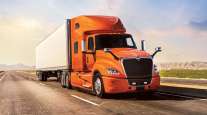SCR Controls Can Be Skirted Using Water, Navistar Claims
This story appears in the July 26 print edition of Transport Topics.
Navistar Inc. attacked competitors’ 2010 engines on two fronts last week, telling environmental regulators that pollution controls on engines using selective catalytic reduction could be easily defeated and telling fleet managers that every gallon of diesel fuel an SCR engine saves will cost at least that much in diesel exhaust fluid consumed.
At a joint state-federal workshop in California, truck and engine maker Navistar presented a 15-minute video that purported to show drivers of SCR-equipped trucks flouting 2010 emissions regulations by operating heavy- and medium-duty SCR trucks for thousands of miles using water instead of diesel exhaust fluid.
Engines with SCR are intended to “de-rate,” or lose power, if their tanks holding the urea-water solution known as DEF are empty. Navistar said that substituting plain water for DEF tricked the tank’s sensors.
“Truck owners are paying a substantial price to comply with 2010 NOx requirements. They and the public deserve to know that the new equipment they are purchasing actually works as promised,” said Jack Allen, president of Navistar’s North American truck group.
Volvo Group and Cummins Inc., both of which sell SCR engines, participated in the July 20 workshop and said their trucks and engines, which have passed 2010 federal and California emission certification, function properly.
In addition to alleging that SCR engines could be run without DEF, which they need to remove NOx, Navistar told reporters July 19 that its exhaust gas recirculation engines are more “fluid-efficient” than SCR-equipped vehicles.
“We’re encouraged because the regulators recognize the importance of this issue,” Navistar’s Allen said after the workshop on SCR compliance, sponsored by the U.S. Environmental Protection Agency and the California Air Resources Board. Navistar asked for the hearing as part of a legal settlement with EPA and CARB when the company objected to regulatory procedures concerning SCR (click here for previous story).
Allen said the video, produced by consulting firm EnSight, shows that a truck operator can fool SCR engine sensors and avoid complying with emissions rules by using tap water.
Navistar is the only U.S. truck OEM that does not use SCR, and Allen said he wants a “level playing field” so that all producers must meet the same standards.
After Navistar screened its video, Volvo-Mack spokesman John Mies said Navistar is a company “that says it is concerned about the environment but whose U.S.-’10 engines will emit 2½ times the 2010 NOx standard and are only certifiable with emissions credits. . . . A competitor that apparently believes that most of its customers — and the trucking industry as a whole — are hell-bent on illegal circumvention of emissions controls . . . that has only been able to compete in the market this year by selling thousands and thousands of pre-2010 engines.”
Steve Berry, spokesman for Volvo Powertrain, who was also at the event, said, “We have seen no evidence of DEF refill or SCR tampering issues in the field and believe it is premature to impose new restrictions in the absence of any evidence of need.”
Mies said Volvo and Mack engines meet the 0.2-gram NOx standard cleanly, whereas Navistar engines emit 0.5 gram per unit of output and use credits, which he called a “loophole,” to make up the rest.
The CARB official who served as co-leader of the meeting said she found the video noteworthy but maintained a degree of skepticism.
“ ‘Oh, my God,’ was the initial reaction, but I think there was also a lot missing. There are holes that need to be filled. We have lots of questions,” said Annette Hebert, chief of CARB’s Mobile Sources Operations Division.
Hebert said CARB staff reviewed massive amounts of engineering data as part of the certification process for diesel truck engines. She said it is her expectation, barring evidence of fraud or tampering, that a new truck with a 2010 engine sold in California would meet the emissions standards for NOx and particulate matter.
She said CARB will review results from actual vehicle operations, and that review could lead to changes in software and programming. Hebert also cautioned that CARB must balance environmental concerns with safety issues.
“We want effective inducements for drivers to comply with environmental requirements, but safely. We don’t want the driver to lose control while the truck is going down a mountain,” she said, offering an example of how an immediate shutdown could be dangerous.
In response to the video, Daimler Trucks North America said its “emissions systems operate as designed, meeting federal and state air-quality standards that reduce particulate matter and nitrogen oxides to near-zero levels without the use of credits.
“DTNA testing and customer experiences also validate that DEF refilling inducements work to consistently and effectively keep each DTNA vehicle operating in compliance with 2010 standards.”
Cummins manager Bob Jorgensen was at the workshop and said the Navistar video broke away too quickly from a Dodge medium-duty truck with a Cummins engine. He said continued filming would have shown the SCR engine de-rate to a 5-mph crawl because of no DEF.
“That is not a profitable operating mode. Our customers like the fuel economy they’ve been getting with these engines, and they’re not going to jeopardize that,” Jorgensen said.




